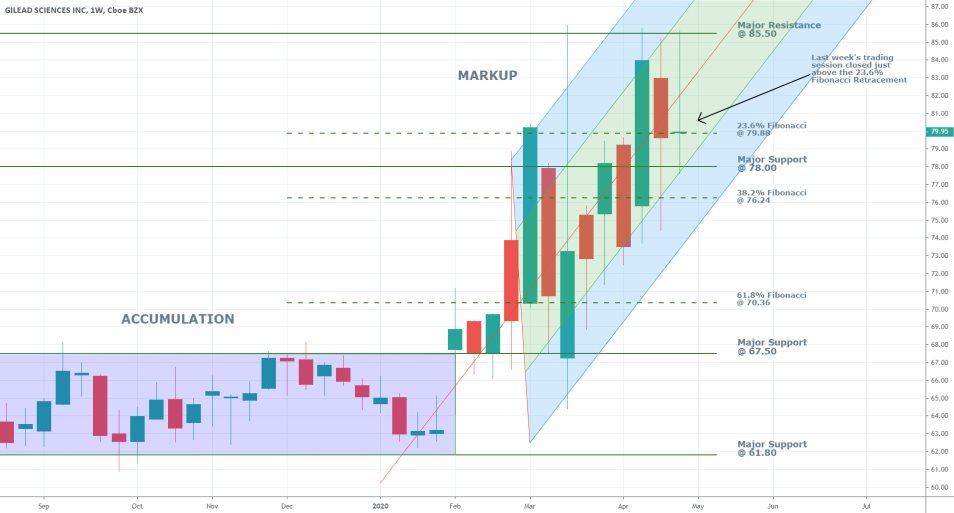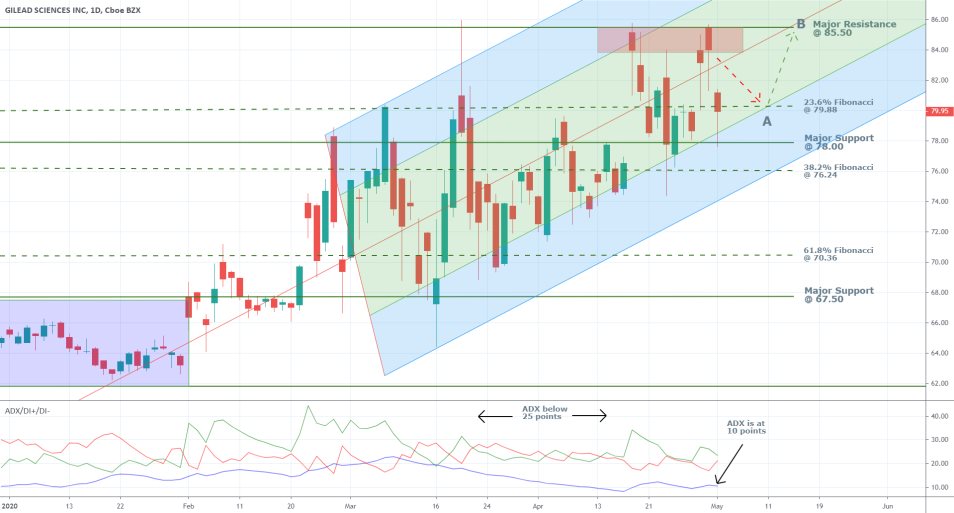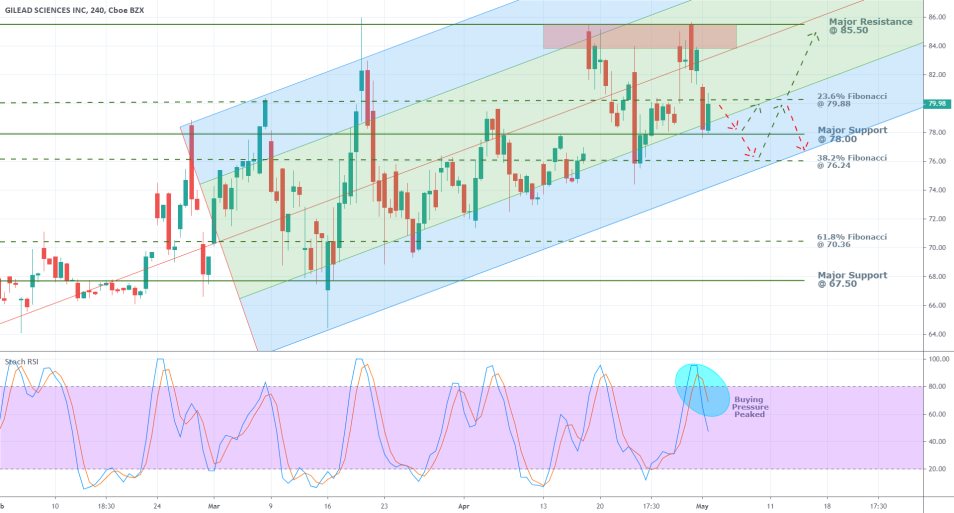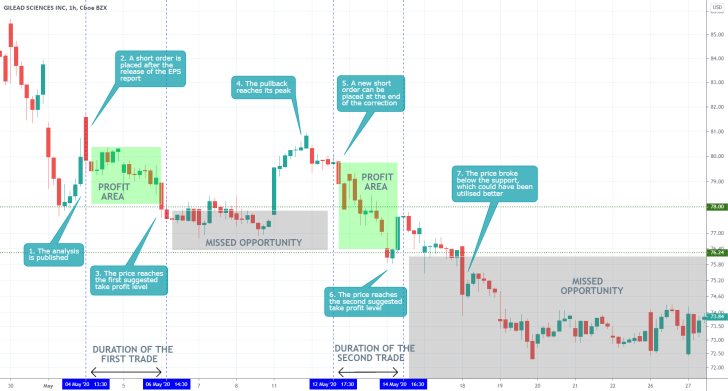Gilead Sciences has become one of the most talked-about companies over the last several weeks, as the Biotech giant's drug Remdesivir, which was originally developed as a medicament against Ebola, is now being used as a treatment for the novel coronavirus with a certain degree of success.
As it was shown in the previous analysis on the company's stock, Gilead is going to be releasing more information regarding the drug's efficiency in helping patients recover from COVID-19, the disease caused by the SARS-Cov-2 virus, over the following weeks and months. Remdesivir is currently undergoing multiple clinical trials, each of those being more intricate and bigger in scope than the one preceding it, and the results from the individual tests are going to be released gradually by the end of the year. That is why the stock price of the company is anticipated to be affected by these developments all the way into 2021.
Two new developments have recently impacted the company's fundamental outlook including the release of Gilead's quarterly earnings report, and the company's CEO stating that Gilead would provide the US government with its entire supply of Remdesivir for free.
That is why the purpose of today's analysis is to evaluate the impact of these new circumstances concerning Gilead's stock value, as well as to review the most recent behaviour of the underlying price action.
1. Long Term Outlook:
As can be seen on the weekly chart below, the stock price continues to advance north, driven by investors' hopes concerning the ultimate success of Remdesivir in treating COVID-19, yet, the underlying trend is an exceptionally volatile one. That is so because of the remaining uncertainty regarding the drug's efficiency. The massive fluctuations in the price action have been caused by traders' reactions to conflicting news, some of which highlighting the drug's efficacy in dealing with the novel disease, whereas others are seemingly suggesting otherwise.

A good example of the stock price's responsiveness to external pressures is the last candlestick on the chart, representing the price action that took place during the previous week. The candlestick has a tiny body, which underscores the indecisiveness of the price action caused by the aforementioned uncertainty. Additionally, last week's trading session has ended with the underlying price closing just above the 23.6 per cent Fibonacci retracement level at 79.88. This is a confirmation of the most substantial SRLs' prominence (support and resistance levels).
Last week's price action has been entirely contained within the inner channel demonstrated by the Pitchfork tool. This means that in the near-term, the price action is likely to continue advancing further north in a similar fashion in spite of the adverse volatility that is distorting the decisiveness of the underlying bullish trend. Moreover, last week's price action rebounded from the major support level at 78.00, which coincided with the lower boundary of the aforementioned channel, as well as from the major resistance level at 85.50, which coincided with the channel's upper edge. This behaviour of the price action confirms both the substantial impact of the aforementioned uncertainty, that is caused by speculations regarding Remdesivir's efficiency, as well as the prevalence of the more important support and resistance levels.
2. Remdesivir's Valuation and Gilead's Earnings Report:
As it was already mentioned, two significant developments from the last few days are currently affecting the fundamental outlook of Gilead's stock. The two shall now be reviewed individually:
- Gilead's Earnings Report for Q1 2020. The company has had a mixed first quarter, with a notable increase in revenue, but a sizable decrease in its net income.
In terms of Earnings Per Share, Gilead managed to beat the consensus forecasts by reporting EPS of $1.68 vs $1.47 expected. The total revenue for the three months leading to March was recorded at $5.54 billion, which measures a 5 per cent increase compared to the $5.28 billion that were generated for the same period last year.
Meanwhile, Gilead's net income for Q1 2020 came in at $1.6 billion, which amounts to a 21 per cent fall compared to the same period in 2019 when the net income was recorded at $1.97 billion. Nevertheless, the Non-GAAP revenue remained virtually unchanged at $2.1 billion.
Daniel O'Day, Chairman and Chief Executive Officer of Gilead Sciences, commented on the performance by stating that:
“Gilead’s performance during the first quarter demonstrates our continued progress and highlights the strength of our underlying business. While we are prepared to navigate the uncertainty and short-term impact from the pandemic, we are confident in our ability to deliver on our long-term goals. Our focus at this time is on both our work with remdesivir and our ongoing commitments to the people who depend on our medicines today.”
The company's stock price tumbled by nearly 5 per cent after the earnings report's release; however, as it was mentioned earlier, the underlying price action managed to finish the trading session above the 23.6 per cent Fibonacci retracement at 79.88, which represents a prominent support level.
Overall, the report demonstrated the extent to which Gilead's financial framework has been hit by the coronavirus pandemic so far, underlined by subdued net income. Nevertheless, the biotech giant has also demonstrated resilience to the coronavirus fallout by maintaining solid revenue streams.
Arguably, the most important conclusion that can be derived from the report is the observation that Gilead has been able to continue making progress towards achieving its long-term goals in spite of the current situation, and also despite the 'increased focus across the organization on rapidly advancing remdesivir'.
" During the first quarter 2020, Gilead continued to make progress in advancing work across each of three long-term ambitions laid out in its corporate strategy: (i) to bring 10+ transformative therapies to patients in the next 10 years; (ii) to be the biotech employer and partner of choice; and (iii) to deliver shareholder value in a sustainable and responsible manner. This progress occurred amid challenges posed by the COVID-19 pandemic and an increased focus across the organization on rapidly advancing remdesivir."
All of this is likely to add value to the company in the long-term, which, in turn, is going to have a positive impact on the underlying stock price.
- Donating Remdesivir. Following the release of the report, on Sunday the CEO Daniel O'Day told CBS' 'Face of the Nation' that the company has donated its entire supply of remdesivir to the US government in a bid to help the latter with its continues effort in treating the over 1 million affected people in the country.
" We intend to get [remdesivir] to patients in the early part of this next week, beginning to work with the government which will determine which cities are most vulnerable and where the patients are that need this medicine. […] We’ve donated the entire supply that we have within our supply chain and we did that because we acknowledge and recognize the human suffering, the human need here, and want to make sure nothing gets in the way of this getting to patients"
Overall, this decision is going to cost the company in terms of net income that could have been collected if remdesivir had instead been sold on the market. Furthermore, Gilead is also going to incur production costs that are not going to be reimbursed, resulting in future losses. Thereby, in strictly financial terms, the biotech company is going to suffer a huge opportunity cost over the current quarter due to its decision to donate its entire supply of remdesivir to the government.
On the other hand, these actions are going to have a substantially positive impact on Gilead's reputation, adding to its Corporate Social Responsibility (CSR). As it had been argued previously, the stocks of companies with well-known CSR programs tend to benefit from extra-added intrinsic value. That is so because companies with high CSR tend to receive more attention from prospect investors, which is what adds the extra value to the underlying stock. Hence, Gilead's share price is likely to continue appreciating in the near future, albeit in a very volatile manner.
3. Short Term Outlook:

As can be seen on the daily chart above, the underlying price action has recently attempted to break out above the major resistance level at 85.50 on three separate occasions but failed to do so. Yet, it has been able to consolidate above the major support level at 78.00, which is good news for the market bulls.
Seeing as how the price action has been advancing roughly within the boundaries of the intermediate ascending channel - its boundaries being represented by the Pitchfork tool – the same behaviour can be expected to persist now that the price has fallen to the channel's lower boundary once again.
Gilead's stock price is most likely going to attempt breaking out above the aforementioned resistance level once again, which is probably going to be a successful effort this time. However, if the price action falls below the 38.2 per cent Fibonacci retracement level, which coincides with the Pitchfork's lowest boundary, this would mean that the bullish sentiment in the market has been terminated.
The ADX is notably threading below 15 points, which means that the market currently finds itself in a range-trading environment. Even though the underlying price action continues to head further north, the market cannot be said to be threading in a definitive bullish trend. Instead, the most distinctive trait of the current market sentiment is the huge amounts of adverse volatility. All things considered, the environment is suitable for the application of swing trading strategies – entering long at swing lows.
The 4H chart below demonstrates the most likely behaviour of the underlying price action in the immediate future, which could be used to determine the most probable swing lows and swing highs.

4. Concluding Remarks:
Overall, Gilead Sciences' company value is most likely going to continue rising in the following weeks and months, as the biotech giant continues pursuing its long-term goals in addition to playing a crucial role in the global efforts against COVID-19. That is undoubtedly going to affect its share price positively.
Nevertheless, traders should be cautious when entering and exiting the market due to the massive amounts of adverse volatility currently impacting the underlying share price.

- Even though the analysis generated net profits, it can be considered as a failure altogether. That is so because the analysis was published after the market had already started going in the expected direction, which lessened the total profits gained. Moreover, the fragmented trades missed a lot of the downswing itself. Also, the analysis did not underpin the possibility of a breakdown below the support at 76.24. Overall, traders need to be certain of the underlying market sentiment before they start implementing appropriate trading strategies.
Disclaimer: Your capital is at risk! Trading and investing on the financial markets carries a significant risk of loss. Each material, shown on this website, is provided for educational purposes only. A perfect, 100% accurate method of analysis does not exist. If you make a decision to trade or invest, based on the information from this website, you will be doing it at your own risk. Under no circumstances is Trendsharks responsible for any capital losses or damages you might suffer, while using the company’s products and services. For more information read our Terms & Conditions and Risk Disclaimer.





















